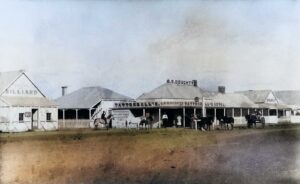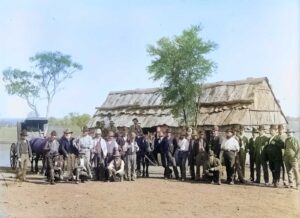The town had barely taken its first breath and opened its eyes and it already had ‘three comfortable hotels’. Gold had been found in 1892 and the town surveyed and gazetted the following year. Shops and businesses quickly lined up along the measured roads, but, according to the Dubbo Dispatch in 1894, the only one not of very primitive design was Mrs Ross’s hotel. This was an interesting comment as Mrs Ross herself was of somewhat primitive design. Susan Ross’s hotel was the Globe, which she ran until 1898, when it was taken over by Henry Harfield.
Susan had a long and hard-working career in running hotels, including a heartwarming episode when she had the Mt Boppy Hotel in Canbelego. During this time, she and her son and daughter-in-law brought actions against each other, the son for defamation of character and the mother for ejectment from the hotel for not paying the rent. During the court case, Susan’s second husband, Mr Rickards, said he would not go back to his wife for £10,000. In the first case, the magistrate found in favour of the son, but imposed the derisory fine of one farthing, or a quarter of a penny. In the second case, he found in favour of the mother – the son and his wife were then liable for the sum of £59. But all that lay in the happy future. In the meantime, Mount Drysdale was figuring out if it was going to be a permanent settlement.
The village acquired a police station, school, public hall, post office, bakery, and a little cemetery, which quickly filled up with people who drowned, were killed in the mines, or got lost in the bush.
One of those who drowned was 5-year-old Charles Smith. He went with his brother and friends to play in the tank, but got into trouble as soon as he entered the water. None of the children could swim and they were too frightened to go for help. It took several hours before they told anyone what had happened, far too late for the little boy. Charles’ father was Henry Smith, publican of the Drysdale Hotel 1899-1901. His death caused his father great distress, and it was not long before Henry Smith gave up the hotel lease and left Mount Drysdale.
The other two ‘comfortable hotels’ mentioned by the Dubbo Dispatch in 1894, primitive or otherwise, were Tattersall’s and the Drysdale, both of these also run by women, Elizabeth Lewis and Ellen Hinds. Tattersall’s was the shortest-lived of the Mount Drysdale hotels. It had only two licensees, Elizabeth Lewis being succeeded by Marion Thomson from 1897 to 1898, after which it appears the hotel closed down.
Mrs Hinds was in it for the long haul, she ran Drysdale Hotel until 1909, when it was taken over by Jim Martin. She did what she could to keep life interesting as evidenced by an ad in The Truth on 17 November 1895:
CHEQUE SALAD
The Truth, 17 November 1895
“The value of a pet kangaroo at the household of Mrs Hinds, of Mount Drysdale, has gone up £4 with a snap. The other day she wanted £6 for the domesticated marsupial, but since then the Australian strayed into the lady’s chamber, and chewed up two cheques for £2 each. Now the proprietor will not part with her pet under £10. She naturally considers him worth his oats, or rather, his notes.”
A fourth hotel to flourish in Mount Drysdale was Doughty’s, run for a time by Samuel Doughty himself (he of the naked lady painting – see the Great Western Hotel story), and at other times by Archibald McDonald and George Carrington. All of these gentlemen had long associations with the hotels of Cobar and the surrounding towns and villages. On its opening, the Western Herald described the hotel as “a thoroughly well-built and commodious structure”. This was in 1895, less than a year after just about everything was primitive. It seems the village was evolving. In the same article, Mr Doughty explained that everyone in Mount Drysdale had other ways of making a living. When times were slack, he and a friend would go out kangarooing and never make less than £4 a week. Just about the extra Mrs Hinds wanted for her domesticated marsupial.
Life was not entirely jolly for Samuel Doughty. In 1906, he sent his only daughter, Zilliah, to Parkes for medical treatment as she was suffering from tuberculosis. Less than a week later, he received a telegram telling him that she had died. The residents of Mount Drysdale, who had honoured Zilliah with a farewell and many little gifts, were very upset. As a mark of respect for her and her family, all the business houses of the village closed for the day.
Samuel Doughty was the licensee in 1908, when the hotel closed its doors. He then sold the building to William Scanlan, who moved it to Elouera, the village of the CSA Mine, some 12kms north-west of Cobar. Mr Scanlan kept the well-known name of Doughty’s on the new site while Doughty himself moved to Cobar and opened a livery stables.
By the time Sam Doughty closed his hotel at Mount Drysdale, the village itself was coming to a slow ending.
The Globe Hotel lasted until 1914. The most exciting thing that happened there, apart from a brawl between the cyanide works supervisor and some miners, was the name of the publican who held the licence for the 1900-1901 period. His surname was Parker, quite unremarkable, but his given name was Onesiphorus. Yup. Onesiphorus. It’s in the Bible, but this doesn’t seem to have affected Mr Parker, or not in any positive way. From Mount Drysdale, he went to Mount Boppy, where in 1903 he was found guilty of trading liquor without a licence, in 1906 of assault, and in 1905, in company with Susan Ross, was charged with using indecent language.
The final licensee of the Globe was Alfred Edwards. He started in fine style in 1907 when he and his wife hosted a grand social, not just for the town residents, but also for the people from the surrounding stations. The festivities started on a Thursday evening and went on until dawn on Friday. While the hotel closed down the following year, it seems the Edwards at least gave everyone something to remember them by.
The last of the hotels to close was the eponymous Drysdale. Jim Martin kept it until 1916. By then, everything in the little town was pretty much over. The school and the police station buildings were dismantled and taken away to be used elsewhere. Other buildings were variously re-used or allowed to decay so that by the 1920s, not much was left to show of what had once been a busy and lively settlement.
In 2022, the Billagoe Mount Drysdale area was listed on the State Heritage Register as an outstanding site of cultural and spiritual significance. This recognises the Indigenous, Chinese, pastoral, mining, and natural history and landscapes.



